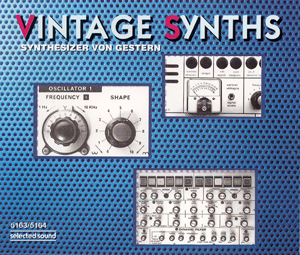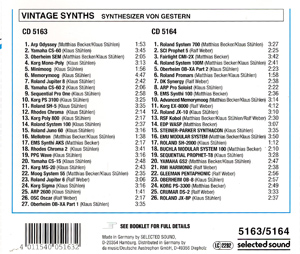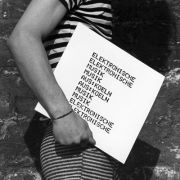

1. Arp Odyssey (1:54)
By the integration of ring modulator and noise generator the Arp Odyssey is quite an impressing instrument capable of some very interesting sounds. We did not find it difficult to make the instrument deliver lots of percussionlike sounds and so this song is a very rhythm-orientated one. Created with the aid of C-LAB NOTATOR und Roland MPU-101.
2. Yamaha CS-60 (3:45)
In matters of sound the instruments of Yamaha's CS-series differ a lot from synths of other manufacturers. The combination of voltage controlled high- and lowpass filter and the very comprehensive LFO-section make this an instrument with a very unique character. No MIDI, therefore played by hand.
3. Oberheim SEM (2:04)
Because the SEM ( "synthesizer expander module" ) by Oberheim comes without noise generator, ring modulator and with only a very basic modulation-section it is only able to produce very clean and very beautiful sounds. The composition was realized without computeraid but with the help of a digital delay with a very long delay time.
4. Korg Mono-Poly (3:16)
A sequence generated by the instruments arpeggiator forms the nucleus of this composition. The sounds used here show that Korg's Mono-Poly can be a very flexible musical tool. Done by hand.
5. Minimoog (1:59)
Naturally here you hear all the stuff which has made the minimoog famous: punchy basslines, very percussive sounds, modulation effects and - last not least - the obligatory solo with pitch bend. Realized with NOTATOR und MPU-101.
6. Memorymoog (4:48)
Because this instrument got its fame mainly for his extraordinary bass and brass sounds you could well call the sounds featured here very untypical for the instrument. We chose them deliberately to make clear that each synthesizer is able to produce lots of sounds beyond the well known clichées. No MIDI-Interface.
7. Roland Jupiter 8 (2:42)
Surely one of the great classic synths because of his extreme variety in terms of sound, realtime editing and very easy programming the Jupiter 8 is a very recommendable instrument which is still in use in lots of professional studios around the world. Because of the excellent MIDI- interface by Groove Electronics not yet being available at the time of recording all the tracks you
hear were played by hand.
8. Yamaha CS-60 (2:07)
This second composition for Yamaha's CS-60 demonstrates even more sound possibilities of this interesting instrument already featured in track no.2.
9.
Sequential Pro One (2:58)
Without any doubt the Pro One would also have been able to play such kind of composition as the one for which we used the ARP Odyssey but our instrument was not 100% tuned by the time of recording so we decided to do a composition that gave us more freedom in terms of tuning.
10. Korg PS-3100 (3:27)
This all-polyphonic instrument also has quite a destinctive character. Especially typical for the PS-3100 are the sound of the filters and the feature of amplitude modulation. Handmade.
11. Roland SH-5 (3:38)
In spite of it's monophonic design and its (only) 12 dB filters this synthesizer from 1976 offers a large number of very different and very convincing tone colours and was one of the sonic surprises of the project. Handcrafted.
12.
Rhodes Chroma (2:15)
The recording of this invention was made with the help of NOTATOR, Wieschiolek-MIDI- Interface and MPU-101. Though without any doubt this track is very interesting musically the sounds used here are in deed very common and those of you looking for more special Chroma Sounds should therefore listen to take no. 18.
13. Korg Poly 800 (2:18)
A small lightweight synth which even can be run on batteries and which in regard to sound is capable of a lot more than one usually expects. Linking to MIDI equipment is no problem at all because of its integrated MIDI interface.
14. Roland System 100 (2:39)
Similar in sound to Roland's SH-5 which is not much of a surprise because both instruments feature the same filter circuitry. Played by hand.
15. Roland
Juno 60 (3:18)
Specialities of this synthesizer are without question its stunning organ replicas, its powerful sound and its very userfriendly editing and programming abilities. Recorded with the help of NOTATOR and Roland MD-8 interface.
16. Mellotron (1:39)
The recording of this short piece of music happened to be very difficult because of the mellotrons wellknown tuning instabilities. To solve the problem we did not use the M 400 of my collection but a Novatron with a quartz-stabilized motor. Unfortunately this also could not overcome our tuning problems, perhaps because of worn out tapes. So we were finally forced to sample the sounds and realize the composition via sampler, computer and MIDI. But still it
sounds like a mellotron, doesn't it?
17. EMS Synthi A (2:17)
The EMS AKS is worldfamous as a "special effects synth" and today Brian Eno still uses it for the sonic editing of sounds. The composition featured here clearly proves that the EMS AKS indeed is a weird little monster. Done by hand.
18. Rhodes Chroma (3:41)
The sonic resources of the Chroma are demonstrated here to quite a larger extent than on track no.12. The fact that in spite of its excellent sound this machine today is used only very seldom in professional studios may be due to it's very complicated programming. Recorded with the aid of Wieschiolek-MIDI-Interface und NOTATOR.
19. PPG Wave 2.2 (3:16)
Together with the Chroma, both Moog synthesizers, the Korg PS-3100, the mellotron and the Yamaha CS-60, the PPG Wave 2.2. is without doubt one of the most impressive electronic beasts presented in this collection. The Wave offers lots of sounds you are not able to produce with any other instrument. Recorded with NOTATOR.
20. Yamaha CS-15 (2:49)
After the SH-5 the CS-15 was the second sonic surprize for us. Small but excellent. Played by hand.
21. Korg MS-20 (2:46)
This probably is the first waltz ever recorded in which all the sounds were generated by a Korg MS-20. Quite typical here: the "peaky" sound of the filters. Handmade.
22. Moog System 55 (2:38)
We finish our journey through yesterdays synthesizer wonderland with a reprise of composition no.1. Typically Moog are the bass sound and the special sounds produced with the help of the fixed filter bank. The solo sound which seems to be a melange of koto and guitar even did surprise us. Unfortunately we probably won't be able to reproduce this sound a second time. Recorded with NOTATOR und Roland MPU-101.
23. Roland Jupiter 6 (3:08)
Roland's Jupiter 6 was one of the first analog synthesizers provided with the MIDI interface. Though the instrument's bass sounds are not quite as convincing as those of its "big brother" the Jupiter 8, its multimode filter an its comprehensive modulation section make it a very capable machine with a unique sonic character.
24. Korg Sigma (3:18)
Though because of its design often mistaken for a preset instrument only suited for for dance musicians the Korg Sigma nevertheless is a very interesting analog synth. Despite the fact that the instrument is only monophonic you can achieve lots of very thick and interesting textures
by layering different sounds. For the lack of any midification this track was played by hand.
25. ARP 2600 (1:43)
The sounds to be heard here are just a tiny little part of the sonic palette of this classic synth because the accent of the composition lies on the gradually shifting of the rhythm rather than on the change of timbre.
26. OSC Oscar (2:19)
This instrument because of its digital waveforms and its multimode filter offers quite a unique sonic character. The separate voices and parts of this fugue were each realized with different sounds and were recorded with the aid of MIDI and computer.
27. Oberheim OB-XA Part 1 (3:37)
The brass and string sounds of this take clearly point out why the OB-XA is one of the great vintage polyphonic synths. The instrument used was not equipped with MIDI but the percussion sounds were put into place via sampling.
28. Roland System 700 (3:28)
Together with the Moog Modular System the Roland System 700 surely is one of the most popular big modular systems ever built. For recording this track we did not make use of a complete system but of a so called LABORATORY UNIT which in regard to its components is very similar to a minimoog. The sound of the System 700 got a bit more punch and power than this of the Roland 100M system. Recorded with the aid of computer and Roland MPU-101 Interface.
29. SCI Prophet 5 (2:26)
Though also one of the great vintage analog synths the Prophet 5 in matters of sound differs a lot from the OB-XA. Because our instrument was not equipped with MIDI the track was played by hand. Only the percussion sounds were triggered as "one shot samples" via MIDI.
30. Fairlight CMI-2X (3:44)
This take was realized nearly completely by using original Samples of the Fairlight's library (SARRAR, SWANEE, CHOIR 5, CAMILLA etc.). Only the surf is not a factory sample but was recorded at the beach of Kokkari (Isle of Samos&Mac218; Greece). The hiss to be heard is the
result of the Fairlight's vintage 8-Bit resolution.
31. Roland System 100M (2:42)
For the recording of this composition we made use of 4 racks with 5 modules each. This awfull lot of oscillators, filters VCAs etc. made it possible to achieve the rich textures to be heard here. Complex modulations of pitch and timbre give a good idea of the sonic capabilities of a large modular system. Recorded with computer and Roland MPU-101.
32. Oberheim OB-XA Part 2 (2:24)
This take demonstrates that the synths built by Oberheim already offered complex modulation possibilities before thr release of instruments like the EXPANDER or the MATRIX 12. You will hear persuading simulations of strings and brass and in the solo part a sync sound which you normally would expect from a Prophet 5 rather an OB- XA.
33. Roland Promars (1:59)
That not only Moog is able to sound like Moog proves the little Roland Promars with this invention which in parts reminds us of the sounds first made famous by pioneer Wendy Carlos on SWITCHED ON BACH. Correct timing thanks to computer and MIDI- interface.
34. DK Synergy I (2:39)
At first glance the Synergy 1 seems to be very restricted in matters of sound with its 24 onboard presets which offer only tweaking but cannot be changed radically. But as soon as you dive deeper into the secrets of this machine you realize that there is a lot to get out of it if you treat this instrument right. Because of its totally digital soundgeneration the Synergy sounds rather different from most of the other vintage synths presented on this CD. Handmade.
35. ARP Pro Soloist (2:23)
This take proves that even with a small preset synth it is possible to realize complex compositions. We made extensive use of the touch sensitivity feature of the keyboard. No computer, no MIDI.
36. EMS Synthi 100 (2:36)
As large as a cupboard this synth is by any means one of the largest synths ever build. Because the tuning stability of its oscillators is very poor, it is suited more for the generation of soundeffects and the processing of sounds than the realisation of harmonically complex
compositions. The sequenzes were made by linking the beast with two analog sequencers (ARP and KORG SQ- 10) for the control of timbre and pitch.
37. Advanced Memorymoog (3:15)
The Memorymoog is featured on this CD again because its possibilities have been largely increased by the LINTRONIC interface developped by Rudi Linhart. The ADVANCED MEMORYMOOG offers excellent tuning stability, can by controlled dynamically and its sounds can be edited via MIDI.
38. Korg EX-8000 (4:13)
We included this in comparison to the other synths featured on this album rather young instrument because we believe it to be a very powerful machine. 'Cause all of its parameters are controllable via MIDI system exclusive data in realtime it is very well suited for the dynamic
control of timbre.
39. Roland JX-10 (3:12)
Roland's former main-axe persuades the listener by its lush strings, its realistic brass sounds and its very clean, yet warm sound.
40. RSF Kobol (2:33)
This 19"- expander made in France is a weird little monster because of such rare features as voltage controllable envelopes, voltage controllable waveshapes and voltage controllable filter resonation. The strange vocal sound was achieved by using a TALKING PEDAL by Electro
Harmonix. The take features a composition that we already used on our first CD to introduce the Moog 55 and the ARP Odyssey. Recorded with the aid of computer and MIDI.
41. EDP WASP (3:10)
Chris Huggett's tiny black-yellow plastic synth is perfect when it comes to generate sizzles, blurbs or squeeks of any kind. Handmade.
42. Steiner-Parker Synthacon (3:35)
Despite not being modular this compact american instrument offers
comprehensive possibilities for modulations of any kind. Its multimode
filter gives the instrument a quite unique and characteristic sound. The
noises were put into groove via sampling because the instrument did not
offer a MIDI interface.
43. Emu Modular System (3:50)
This extremely rare modular system is well known for the tuning stability
of its oscillators and its excellent filters. The tracks "wood" and "metal"
sounds were generated with the systems ring modulator, the sound of the
solo line was changed in realtime during recording by tweaking the knobs
of the resonant filter. No samples were used at all but the system was
controlled by a Roland MPU-101 MIDI- Interface und C-LAB Notator
Software.
44 Roland SH-2000 (1:12)
Many of the sounds produced here by this small monophonic synth are
very similar to some of those first made famous by "Switched On Bach"
composer Wendy Carlos. The track was recorded with one shot samples
and the aid of C-LAB's NOTATOR software.
45. Buchla Modular System 100 (2:11)
This composition with Don Buchlas first modular synthesizer from 1969
came into being without MIDI or computer.The main ingredient of the
track are noises of different colours which start grooving thanks to a
Roland 700 sequencer. A click track on the 24-track is fed into the
sequencer's pulse shaper and thus controls the synchronization of the
many different layers. Note the extremely wide stereo image achieved
with the aid of QSOUND.
46. SCI Prophet T-8 (3:28)
The largest model out of Sequential's series of analogue synthesizers
persuades with powerful brass sounds and a solo line with a sync lead
sound similar to those of Jan Hammer fame. The instruments overall
sound is very similar to this of its "little brother" the Prophet 5. Recorded
with the aid of MIDI and computer.
47. Yamaha GS2 (2:48)
Only standard factory presets were used for the realisation of this
composition. Most convincing are the brass and string sounds of the GS-
2, but the noise inherent in the 8-bit FM-technology of this instrument is
so loud that even DINR failed in removing it completely.
48. RMI Harmonic (2:40)
Because of its special way of sound generation (digital oscillators) the
RMI Harmonic offers very characteristic and unique sound colours. As
the instrument was not midified we made extensive use of one shot
samples.
49. Gleeman Pentaphonic (2:56)
Gleeman's Pentaphonic is a 5-voice instrument with a sound which - to a
certain extent - reminds the listener of the Prophet 5 by Sequential
Circuits though its modulation possibilities are not as powerful as those of
its famous colleague. Realized via one shot samples and C-LAB
NOTATOR.
50. Oberheim OB-8 (2:57)
This composition presents once more the typical strength of the Oberheim
synthesizers: convincing brass and string sounds as well as interesting
percussion timbres. Realized with the integrated MIDI-interface and C-
LAB NOTATOR.
51. Korg PS-3300 (2:53)
Though this "Rolls-Royce" of Korg's PS series is playable fully
polyhonic it also can be - as clearly demonstrated here - used for the
generation of experimental timbres of many kinds. The track was recorded
without MIDI; the basic timing was taken from a LFO modulation, the
echoes were supplied by a LEXICON JAM MAN.
52. Crumar DS-2 (3.33)
The italian Crumar DS-2 is a flexible and rather underrated instrument
thats capable of the generation of powerful bass lines as well as - thanks to
his two independant LFO's - very complex modulation sounds.
53. Roland JX-8P (2:38)
ROLAND's JX-8P persuades by warm and powerful sounds of a quality
comparable to this of the Oberheim range. Despite the programming of
the JX-8P being a lot more difficult than this of a Oberheim PB-8 or
OBX-A the Roland still might be worth a try, as our example shows.
Recording via MIDI and C-LAB NOTATOR.
